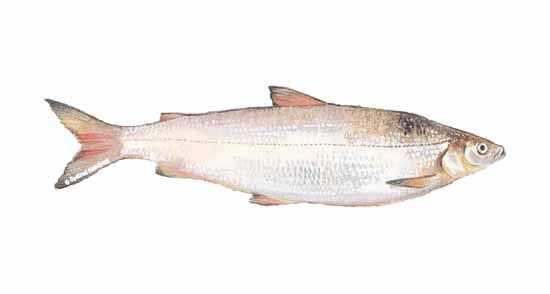Lake Whitefish

Species Details
Coregonus Clupeaformis
Salmonidae
Salmoniformes
Coral Reefs, Sand, Inshore, Nearshore
2 - 15 lbs.
12" - 39"
Lake Whitefish (Coregonus Clupeaformis) Fish Description
The lake whitefish is a North American freshwater whitefish that lives in all of the Great Lakes in the United States and is present in most of Canada. It is often called a "humpback" fish because of its small head in comparison to the length of its body. It is a member of the salmonid family and is closely related to salmon and trout. Other names this species is known as are Otsego bass, Sault whitefish, gizzard fish, common whitefish, eastern whitefish, and whitefish from the Great Lakes.
Similar to round whitefish, it is a moderately-deep bodied fish with a greenish-brown back and silver-white underbelly. Its snout hangs over its mouth and there are 2 flaps of skin in the center of its nostrils. When the lake whitefish age, their heads look even smaller because a fleshy bulge at the shoulders will appear.
Lake whitefish have high commercial value but because of their small mouths, can be challenging to catch. Their thin, highly delicate mouth restricts their diet to insects, freshwater shrimp, small fish, and fish larvae and you will find them feeding on or around lake-bottoms.
Interesting facts about the Lake Whitefish
- The lake whitefish have fed the people of the Great Lakes since the Native American era. The Ojibwe word for Great Lakes whitefish is Atikamig.
- In 2006, researchers found breeding lake whitefish and fertilized eggs in the Detroit River which were the first recorded evidence in the area since 1916.
Lake Whitefish Size
The lake whitefish is a medium to large fish with an average length of about 12-26 inches and a weight of 2-4 lbs. The commercial catch usually measures 17-22 inches in length and weighs 1.5-4 pounds. The largest lake whitefish on record was over 42 pounds and was taken in 1918 from Lake Superior.
Lake Whitefish Habitat & Distribution
In November and December, whitefish spawn, usually in the shallow bottom waters of the lake that are less than 25 feet. These fish school up in the dim, cold waters of the Great Lakes as the water levels elevate, and they will often retreat as far as 200 feet below the surface.
Mature whitefish reach the shallow water in the fall to lay their eggs on embankments of debris, and the young will hatch in the coming spring. In late summer, a great spawning migration meets with the Athabasca Delta in northwestern Canada, flowing upstream into the Athabasca Channel. The furthest recorded migration of a whitefish was 241 miles, from Fort McMurray to the north shore of Lake Athabasca in Alberta, Canada.
Lake Whitefish Fishing Technique
Whitefish produce the largest revenue in the United States and Canada for commercial fisheries in the Great Lakes. For the most part, commercial fishing is carried out using trapnets and gillnets laid down during the open water season.
Though not generally regarded as a game fish, this species has been the focus of active sport fishing in many areas of its range in recent years. It is caught by anglers on a small hook usually baited with a fish egg.
It is also recommended to catch Lake whitefish by fly fishing during winter and spring. They go out to feed only in the day during autumn and early winter. When mayflies are abundant in number, you can go fly fishing for them by using a fly on the water’s surface. On an ultralight to medium power spinning rod, lake whitefish can be caught, and even a fighter can be tamed with a 6- to 10-pound test on a medium-capacity spinning reel, an acceptable drag setting, and good coordination.
A tiny jig floating near the surface under a float or casting bubble would attract lake whitefish. Without hanging up, this rig may also be drifted or slowly recovered around rocky reefs and points. Other common baits to use would be teardrop jigs with wax worms or small minnows (live or salted).







